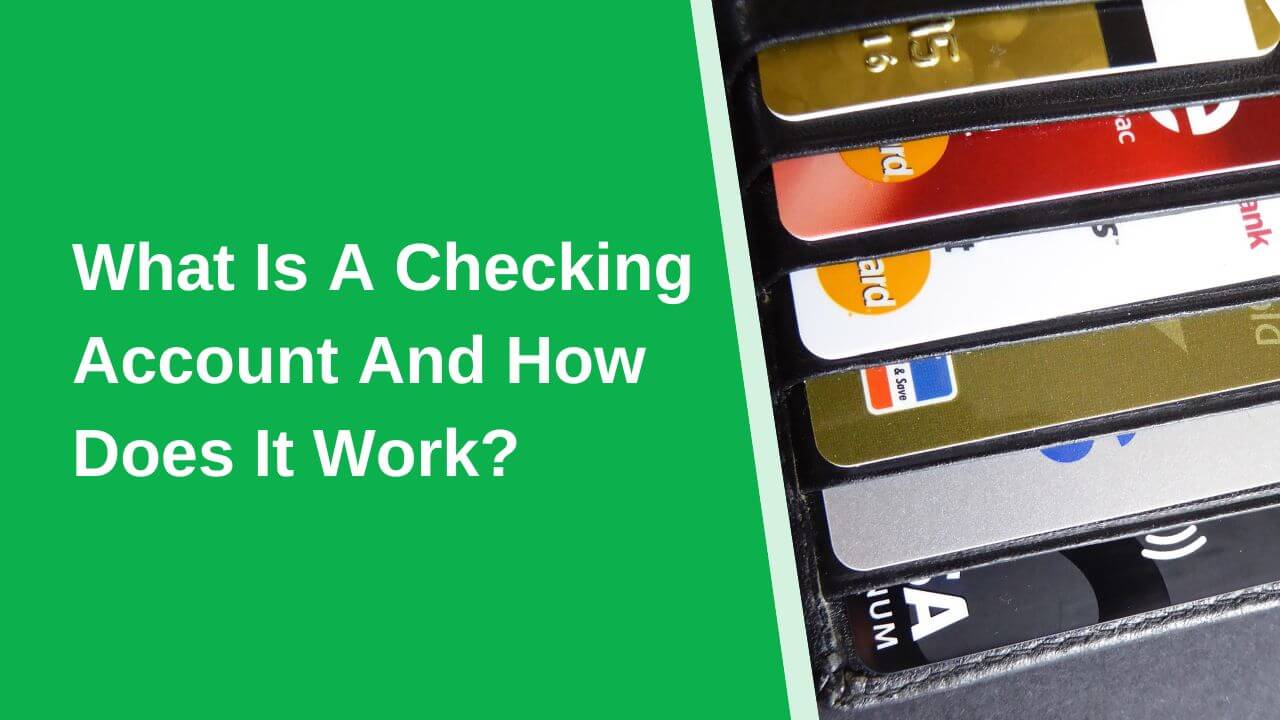A checking account is a hub for an individual’s finances. It’s a place to stash money, make bill payments, and generally keep track of spending. Checking accounts are offered by both banks and credit unions, and they come with a debit card that gives account holders access to their funds at ATMs and point-of-sale terminals.
Checking accounts differ from savings accounts in that they are designed to be used on a daily basis rather than for long-term storage. The money you keep in your checking account is money that you will withdraw for the short term to pay for necessary expenses.
There are different types of checking accounts, but most share some common features:
- A routing number and account number that identifies the account
- An option to set up direct deposit
- The ability to write checks or use a debit card for purchases
- Fees, including a monthly maintenance fee, ATM fees, and overdraft fees
How Do Checking Accounts Work?
Checking accounts are quite simple. You open a checking account at a bank or credit union and deposit funds into it. The bank may pay you interest on your balance, though usually less than on a savings account because checking accounts are meant for money movement, not saving.
There are many ways to add funds to your checking account. The typical methods of adding money to a checking account are:
- Direct deposit. Direct deposit is the easiest way to add money to your account if your employer offers it. With direct deposit, your paycheck is automatically deposited into your account on payday.
- Mobile check deposit. Mobile check deposit allows you to deposit a check by taking a photo of it with your smartphone.
- ATM deposits. ATMs typically accept checks, which will then be picked and deposited by the ATM company and your bank.
- At-bank deposits. At-bank deposits are made by physically going to the bank and adding money to your account.
- ACH deposits. ACH deposits are electronic transfers from another account, such as a savings account or PayPal account.
- Wire transfers. Wire transfers are also electronic deposits, but they typically come from another bank.
When you wish to access or spend your checking account money, there are a number of ways to do so.
- Checks. Checks can be written in checkbooks and given to parties as payment, where your bank will transfer the designated funds to the recipient.
- ACH transfers. ACH or electronic transfers are online transactions that you can schedule to send money either into or out of your checking account. This includes things like paying bills.
- Wire transfers. Wire transfers can be used to send or receive substantial amounts of money to and from bank accounts in the United States and other countries.
- Debit cards. Whether you want to use it in-store or online, at ATMs, or for deposits and withdrawals, a debit card with either a Visa or Mastercard logo will work just fine.
- ATM cards. ATM cards are not interchangeable with credit or debit cards. They can, however, be used to make deposits or withdrawals at ATMs. You cannot use them for purchasing.
- Person-to-person (P2P) payments. You may use your bank account to send money to someone else electronically via the email address or account information using a person-to-person payment.
Mobile wallets are an increasingly popular way to make secure transactions online or in stores. Your bank may offer mobile wallet capabilities, such as being able to add your debit card to Google Pay or Apple Pay.
Benefits Of Opening A Checking Account
Checking accounts are a must in the modern financial world. They are in many cases the hub through which all of your money will flow. When you are paid, it should be deposited into your checking account because savings accounts often have restrictions on how many transfers can be made in a month.
Your checking account can easily send funds to your savings account(s), Venmo, PayPal, investment accounts, and credit cards. It can link to almost any account to pay and receive funds, like a router, that manages incoming and outgoing communications from your house.
Your Deposits Are Federally Insured
The Federal Deposit Insurance Corporation (FDIC) or National Credit Union Administration (NCUA) protects your money up to $250,000 per depositor per institution in case the bank or credit union fails.
You Can Access Your Money Easily
While it may take a few days for funds to become available after you deposit them, your checking account is the easiest way to access your money. It is much more than accessing your investments like stocks and bonds and allows for more transactions than your savings account. In other words, a checking account is the best way to securely and quickly access your money.
It Makes Bill Paying Safe And Easy
Having money in the bank makes it simpler to pay your bills and basic expenses. You can set up direct deposit from your employer so your paychecks are automatically deposited into your account. You can also schedule automatic payments for your rent, mortgage, car loans, insurance, and other bills. This way, you never have to worry about forgetting to pay a bill or losing a check.
It Can Keep Your Cash Safe
Keeping your money in a checking account also offers some security. If you keep cash at home, for example, it may be stolen. Wearing a wallet full of cash puts you at risk of robbery or loss. However, when your funds are kept in a bank insured by the FDIC or NCUA, they are protected up to the total coverage limit.
Linking your checking account to a company like Venmo will allow you to have the same access to your money as cash, with added protection.
If you’re working towards your personal financial goals, check out our article – 11 Realistic Ways To Reach Your Personal Financial Goals.
Types Of Checking Accounts
There are three major types of checking accounts: basic, interest-bearing and student. Each type of account has its own pros and cons, so it’s important to choose the one that best fits your needs.
Basic Checking Accounts
A basic checking account is a no-frills account that offers the essentials: the ability to deposit and withdraw money, write checks and use a debit card. Basic accounts typically have low monthly fees, if any, and don’t require a minimum balance. They also tend to have fewer features than other types of accounts.
Interest-Bearing Checking Accounts
An interest-bearing checking account is a basic checking account that also earns interest on the money you deposit. While the interest rate is usually lower than what you’d earn on a savings account, it’s still higher than what you’d get with a basic checking account. Interest-bearing checking accounts often require a minimum balance, and they may have higher fees than basic accounts.
Credit Unions and online banks often have competitive interest rates for their interest-bearing checking accounts.
Student Checking Accounts
A student checking account is a type of interest-bearing checking account designed for college students. They typically have low or no monthly fees and may offer other perks like free ATM withdrawals or waived fees for using out-of-network ATMs. Student accounts also often come with tools to help manage money, like budgeting advice and notifications when a balance gets low.
How To Open A Checking Account
The process of opening a checking account is relatively simple. You’ll just need to choose the right bank or credit union and gather the required documents. Once you have everything you need, you can open an account in person, online, or by mail.
- To open a checking account, you’ll need:
- A government-issued ID, like a driver’s license, passport, or state ID card
- Your Social Security number
- Your date of birth
- Proof of your current address, like a utility bill or lease agreement
Once you have all the required documents, you can open an account online, in person or by mail. When you open an account online or by mail, you’ll usually need to fund it with a check, bank transfer, or money order. If you open an account in person, you can typically fund it with cash or a check.
Once your account is open, you’ll be able to deposit money and start using it right away.
Choosing The Right Checking Account
With so many different banks and credit unions to choose from, it can be hard to know which one is right for you. To find the best checking account, consider your needs and compare your options.
If you’re an international student in the U.S., check out our article on – Setting Up Finances In The U.S. For International Students.
Here Are A Few Things To Look For When Choosing A Checking Account:
Low or no monthly fees: You shouldn’t have to pay a lot of money just to keep your checking account open. Look for an account with no monthly fee, or a low monthly fee that can be waived if you meet certain requirements, like maintaining a minimum balance.
Free ATM access: If you use an out-of-network ATM frequently, look for an account that offers free withdrawals. Some accounts will reimburse you for the fees charged by ATM owners.
High-interest rates: If you want to earn interest on your checking account balance, look for an account that offers a competitive rate. Keep in mind that you may need to meet certain requirements, like maintaining a minimum balance, to earn interest.
No minimum balance requirements: Some banks require you to keep a minimum amount of money in your account to avoid fees. If you don’t want to worry about meeting a minimum balance requirement, look for an account that doesn’t have one.
Overdraft protection: Overdraft protection can help you avoid fees if you accidentally spend more money than you have in your account. If this is something you’re interested in, look for an account that offers it.
Here Are Some Accounts That We Recommend:
Quontic Bank High Interest Checking
Quontic boasts a 3-minute ultra-fast setup time and a low $100 minimum deposit for Quontic’s High Interest Checking accounts. As an online-only bank, Quontic can help you no matter where you are in the US, removing the need to go to a brick-and-mortar bank.
Key features:
- Earn 1.10% APY on all balances
- Open an account online in just 3 minutes
- No monthly maintenance fees or minimums
- $100 minimum deposit required to open an account
- 90,000 fee-free ATM locations
It is important to note that you will need to make 10 debit card point-of-sale transactions of $10 or more per statement cycle required to earn the maximum APY (Annual Percentage Yield) per account balance tier. If the qualifying activity requirement is NOT fulfilled, the interest rate paid on the entire balance will be 0.10% APY. Please visit our website for a list of non-qualifying activities.
You can easily do this by buying groceries or meals with your Quontic debit card!
Axos Bank Essential Checking
Axos Essential Checking offers a no-fee 100% online checking account option. If you want direct deposit from employers and ATM fee reimbursement, this is a great account for you.
Key features:
- No monthly fees
- Unlimited ATM fee reimbursements
- Early direct deposit
- Referral bonus when you invite friends
- 100% mobile and online banking
Axos Bank Cashback Checking
Axos offers a cashback checking account that requires only a $50 deposit to open. With up to a 1.25% APY (annual percent yield) and ATM fee reimbursement, this is a great first checking account.
Key features:
- No monthly maintenance fees
- 15 minutes to set up
- Unlimited domestic ATM fee reimbursement
- Up to 1% cashback on signature-based purchases
- Only $50 to open an account
The Truth Of It
To function in the adult world, you will need a checking account. When searching for a checking account that’s right for you, there are many options with low minimum balance requirements and little to no monthly fees. Narrow down your choices by making a list of the features and benefits that matter most to you. Also, think about whether online banking would be a good fit for the way you manage your money.
Now that you know about checking accounts, you may want to explore more about savings accounts, check out our article – What Is A Savings Account And How Does It Work?







